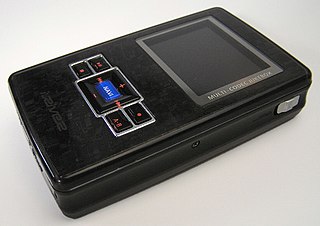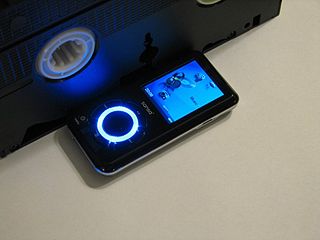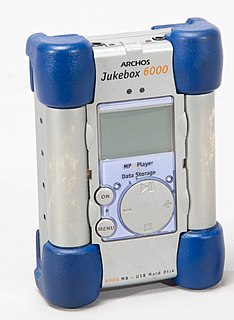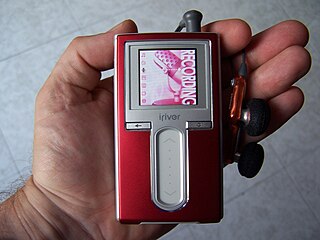iRiver, stylized IRIVER and formerly as iriver, is a South Korean consumer electronics division owned by Dreamus which markets music and other accessories in its domestic market.

ZEN is a series of discontinued portable media players designed and manufactured by Creative Technology Limited. The players evolved from the NOMAD brand through the NOMAD Jukebox series of music players, with the first separate "ZEN" branded models released in 2004. The last Creative Zen player, X-Fi3, was released at the end of 2011.

Rockbox is a free and open-source software replacement for the OEM firmware in various forms of digital audio players (DAPs) with an original kernel. It offers an alternative to the player's operating system, in many cases without removing the original firmware, which provides a plug-in architecture for adding various enhancements and functions. Enhancements include personal digital assistant (PDA) functions, applications, utilities, and games. Rockbox can also retrofit video playback functions on players first released in mid-2000. Rockbox includes a voice-driven user-interface suitable for operation by visually impaired users.

The Western Digital Raptor is a discontinued series of high performance hard disk drives produced by Western Digital first marketed in 2003. The drive occupies a niche in the enthusiast, workstation and small-server market. Traditionally, the majority of servers used hard drives featuring a SCSI interface because of their advantages in both performance and reliability over consumer-level ATA drives.

A portable media player (PMP) is a portable consumer electronics device capable of storing and playing digital media such as audio, images, and video files. The data is typically stored on a compact disc (CD), Digital Video Disc (DVD), Blu-ray Disc (BD), flash memory, microdrive, or hard drive; most earlier PMPs used physical media, but modern players mostly use flash memory. In contrast, analogue portable audio players play music from non-digital media that use analogue signal storage, such as cassette tapes or vinyl records.

The iRiver H300 series are a series of portable audio players developed by iRiver, made up of the iRiver H320 and H340 models. They were first announced on September 22, 2004 replacing the H100/iHP-100. Each can play music, transfer pictures directly from digital cameras and UMS-compatible devices, such as flash drives, and display digital images on a colour screen. In the United States, the H320 initially retailed for $329 and the H340 was $429.
PortalPlayer, founded in 1999, was a fabless semiconductor company that supplied system-on-a-chip semiconductors, firmware and software for personal media players. The company handled semiconductor design and firmware development, while subcontracting the actual semiconductor manufacturing to merchant foundries.

The loosely defined category of S1 MP3 players is comprised by a large amount of then-inexpensive handheld digital audio players. The players were mainly widespread around 2005–2006 but the series continued for years afterwards, blurring into that of so-called "MP4 players" employing S1 and competing architectures.

Yepp was Samsung Electronics' digital audio player brand until Samsung decided to retire most of their family brands in February 2011. From then on, their MP3 players were simply branded "Samsung" worldwide until they discontinued all of them in late 2013. The brand included a wide range of hard-drive based as well as flash-memory based players. The name is claimed to be an acronym for "young, energetic, passionate person".
The Gigabeat was a line of digital media players by Toshiba.

The Deskstar was the name of a product line of computer hard disk drives. It was originally announced by IBM in October 1994. The line was continued by Hitachi when in 2003 it bought IBM's hard disk drive division and renamed it Hitachi Global Storage Technologies. In 2012 Hitachi sold the division to Western Digital who continued the drive product line brand as HGST Deskstar. In 2018 Western Digital began winding down the HGST brand and as of 2020 it is defunct.

The Sansa e200 series is a portable media player developed by SanDisk, and released on January 5, 2006. The device is available in four capacities of Flash memory: 2 GB (e250), 4 GB (e260), 6 GB (e270), and 8 GB (e280). All players have a 1.8-inch, TFT LCD display with a resolution of 176 by 220 pixels. Certain files, if not in a format accepted by the player's original firmware, must first be converted with the Sansa Media Converter Windows software. This will convert images to bitmap format (.bmp) and videos to MJPEG, for v1 models. On v2 players it will convert videos to DivX and simply resize images. It is not possible to simply copy videos to the device, even if they seem to be in the correct format; trying to access them displays an error message.

SanDisk has produced a number of flash memory-based digital audio and portable media players since 2005. The current range of products bear the SanDisk Clip name, a line of ultraportable digital audio players. SanDisk players were formerly marketed under the Sansa name until 2014.

The Archos Jukebox is a series of Archos portable audio players from 2000 through 2002.

The Zune 80 and Zune 120 are portable media players developed by Microsoft in its Zune series of media players. The Zune 80 was announced on October 2, 2007 and was released on November 13, 2007. It, along with the Zune 4, 8, and 16, is part of the second generation of Zune devices. It features music, video, and podcast support, and comes with Wi-Fi and FM Radio. The Zune 120, part of the second generation of Zune devices, was released September 16, 2008. As of January 2010, the devices run the 3.3 firmware.
The iRiver E100 is a portable media player developed by iRiver. It features a 2.4" TFT LCD 320x240 colour screen, built-in 1 watt speakers, a line in port and a microSD card expansion slot up to 8GB. The user interface is navigated by using the iRiver "D*Click" scheme. However, the controls are isolated to the lower section of the device's front. There are minimal buttons located on the side of the device including a power button and two-in-one volume bar. There is also a "hold" switch located on the other side of the device.

The Seagate Barracuda is a series of hard disk drives and later solid state drives produced by Seagate Technology that was first introduced in 1993.
The French consumer electronics company Archos manufactured a number of products which have since been discontinued.

The H10 is a series of portable audio players developed by iRiver, coming in multiple capacities and sizes. The player first went on sale in South Korea in December 2004 and rolled out internationally soon afterwards. The H10 series are hard disk based players coming in a 20 gigabyte form, along with smaller variants of 5 or 6 gigabytes. All versions come with a colour screen as well as voice recording and FM radio. Unlike most other iRiver products, the H10 series does not play Ogg Vorbis. However, the device works well with the Rockbox alternative firmware which does play Ogg Vorbis.














